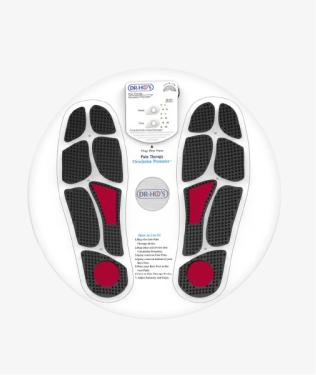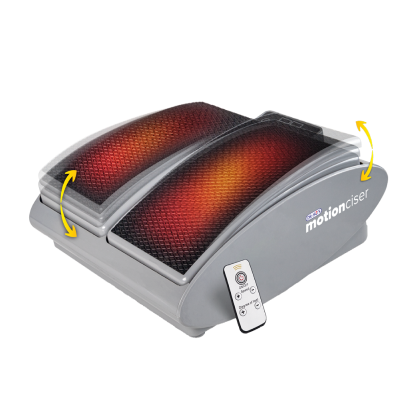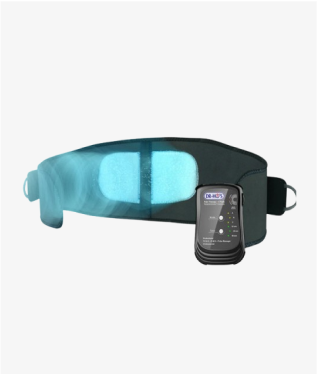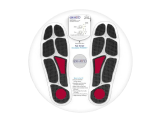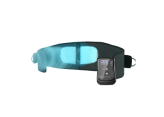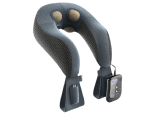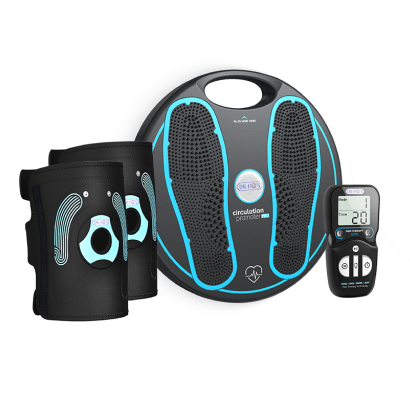As we age, maintaining strong, healthy legs becomes increasingly vital for independence, mobility, and overall quality of life.
Yet for many seniors, traditional exercise approaches can feel daunting, uncomfortable, or simply out of reach. The solution isn't to give up on leg health. It's to embrace innovative approaches like DR-HO’S MotionCiser that work with your body's natural healing processes rather than against age-related limitations.
Why leg exercise matters more in later years
Strong legs serve as the foundation for nearly every aspect of daily living. Whether you're rising from a chair, climbing stairs, or simply maintaining your balance while standing, your leg muscles and joints work together to keep you mobile and independent.
Regular leg exercise provides multiple benefits that extend far beyond muscle strength. Walking, swimming, cycling, and targeted leg workouts help maintain cardiovascular health, support healthy circulation throughout the lower extremities, and preserve the flexibility and range of motion essential for daily activities. These activities also contribute to bone density, helping prevent the fractures that can dramatically impact quality of life.
For many adults, traditional approaches to leg exercise include daily walks, recreational activities like dancing or gardening, and purposeful exercise routines. Swimming provides excellent low-impact conditioning, while resistance training with light weights or exercise bands can help maintain muscle mass. Even household activities like climbing stairs or walking to the mailbox contribute to leg strength and endurance.
However, the importance of leg strength extends beyond general fitness. Research (J Nutr Health Aging) consistently demonstrates that leg muscle power—the ability to generate force quickly with the lower extremities—is a critical predictor of functional independence in older adults. Leg muscle power is also a predictor of disability among older adults, with lower leg power serving as an early indicator of poor function, while higher leg power may indicate preserved physical function.
Strong legs also play a crucial role in fall prevention, which becomes increasingly important with age. Approximately 28-35% of adults over 65 experience a fall annually, with that figure rising to 32-42% for individuals over 70 (Front Neurol.). Many of these falls result from leg weakness, balance issues, or the inability to quickly recover when stability is challenged.
Why traditional exercise may become difficult with age
While the benefits of leg exercise are clear, the reality is that traditional approaches become increasingly challenging as we age. The statistics tell a sobering story: approximately 38% of older adults report mobility or self-care limitations (Freedman VA. The Demography of Late-Life Disability , while 24% use assistive devices like canes, walkers, or mobility scooters (J Am Geriatr Soc.).
Several factors contribute to these challenges. Physical limitations often develop gradually, making it harder to maintain previous activity levels. Approximately 50% of seniors have diagnosed osteoarthritis (MMWR Morb Mortal Wkly Rep.), a condition that causes joint pain, stiffness, and reduced range of motion. The chronic pain and joint stiffness associated with arthritis can make traditional exercise uncomfortable or even painful, leading many to reduce their activity levels precisely when they need movement most.
Chronic health conditions further complicate the exercise equation. Around 28% of seniors have diagnosed diabetes, while an additional 50% may have prediabetes—meaning up to 78% of seniors deal with blood sugar management issues that can affect energy levels and circulation (NCHstats). Cardiovascular disease affects ~71% of seniors in various forms, potentially limiting exercise capacity and endurance (Circulation).
Recovery from medical events presents additional obstacles. Stroke survivors, individuals recovering from hip or knee replacements, and those managing conditions like peripheral neuropathy often find traditional exercise programs too demanding or potentially risky. The fear of falling or re-injury can create a cycle where reduced activity leads to further muscle weakness and increased fall risk.
Balance and coordination challenges add another layer of complexity. Many traditional leg exercises require the ability to stand safely, maintain balance, or coordinate complex movements. For seniors with vestibular issues, medications that affect balance, or simply the natural changes in proprioception that occur with aging, these requirements can make standard exercise routines feel unsafe or overwhelming.
Weather and transportation barriers shouldn't be overlooked either. Limited mobility may make it difficult to access gyms, pools, or safe walking areas, while seasonal weather changes can restrict outdoor activities for months at a time.
This is where the concept of passive motion therapy becomes particularly valuable. Rather than requiring seniors to generate all the movement themselves—potentially working against pain, limited range of motion, or balance concerns—passive motion technology provides gentle, controlled movement that works with the body's natural mechanisms for maintaining joint health and circulation.
Understanding passive motion technology: A gentle revolution in leg health
Passive motion therapy in the form of a leg exerciser represents a fundamentally different approach to maintaining leg health and mobility. Instead of requiring you to actively generate movement through muscle contraction, passive motion devices provide controlled, gentle movement that helps maintain joint flexibility, supports circulation, and encourages muscle activation without strain or effort.
The concept behind passive motion therapy is based on the principle that regular, gentle movement helps maintain joint health. Passive motion exercise has been used to help patients maintain joint range of motion following surgery or injury.
The principle is straightforward: Regular, gentle movement helps prevent joint stiffness, maintains tissue flexibility, and supports the natural processes that keep joints healthy.
Introducing the DR-HO'S MotionCiser leg exerciser
The DR-HO'S MotionCiser brings the benefits of passive motion therapy directly to your home in a convenient, user-friendly design. This innovative exercise device combines three therapeutic approaches: Continuous passive motion, high-frequency vibrational massage, and therapeutic heating.
Unlike simple vibration plates that only provide vibration, the MotionCiser's innovative approach combines continuous passive motion with high-frequency vibration. This dual-action technology works with your body's natural movement patterns while you remain comfortably seated.
The MotionCiser works by simulating the natural walking motion while you sit comfortably in your chair. The device gently moves your feet and legs through a controlled range of motion that encourages movement throughout the lower extremities, from your feet and calves up through your knees and hips. This passive movement helps combat the effects of prolonged sitting and supports healthy circulation without requiring you to stand, balance, or generate the movement yourself.

How the MotionCiser works to support leg mobility
Using the MotionCiser is remarkably simple. You place your feet on the device (with or without shoes), select your preferred settings using the convenient remote control, and relax while the device does the work. The MotionCiser offers 10 different vibration speed levels, allowing you to customize the intensity to match your comfort level and therapeutic needs.
The therapeutic heating feature provides five temperature settings, helping to address cold feet while soothing muscles throughout the treatment. This combination of movement and warmth works synergistically; the gentle heat helps relax muscles and improve tissue flexibility, while the passive motion supports circulation and joint mobility.


The device's high-frequency vibrational massage adds another therapeutic dimension. These gentle vibrations help stimulate nerve pathways and encourage movement, potentially providing benefits similar to traditional massage therapy. The combination of passive motion and vibration creates a comprehensive treatment that addresses multiple aspects of leg health simultaneously.


Key benefits for seniors
The MotionCiser offers several advantages, particularly relevant for senior users. The passive nature of the treatment means you don't need to worry about balance, coordination, or generating sufficient strength to benefit from the therapy. Whether you're dealing with arthritis pain, recovering from a medical procedure, or simply looking to maintain leg health despite limited mobility, the device accommodates your current abilities rather than demanding improvements.
The seated operation eliminates fall risk, making it safe for individuals with balance concerns or those who use mobility aids. You can use the MotionCiser while reading, watching television, or simply relaxing, making it easy to incorporate regular leg therapy into your daily routine.
For those managing chronic conditions, the gentle approach provides movement benefits without the potential stress or discomfort of traditional exercise. Studies suggest that osteoarthritis, diabetes mellitus, and cardiovascular disease are associated with lower leg power compared to older adults without these conditions, but individuals with these conditions have shown improved leg mobility with appropriate interventions.
Recommended usage
DR-HO'S recommends using the MotionCiser 3 to 5 times daily for 20-minute sessions to help combat the effects of a sedentary lifestyle or prolonged standing. This frequency allows you to incorporate leg therapy throughout your day—perhaps a morning session to help with circulation, an afternoon session to break up prolonged sitting, and an evening session for relaxation and muscle relief.
The device is designed for use while sitting and should not be used while standing. This makes it perfect for use with adjustable desks, allowing you to maintain leg movement even during seated work or leisure activities.

MotionCiser V2. - Heated Passive Leg Exerciser - Essential Package
$259.99 USD
Complementary approaches for comprehensive leg health
While the MotionCiser provides an excellent foundation for maintaining leg health, a comprehensive approach to senior leg care often benefits from multiple strategies working together. The key is finding the right combination of therapies that work within your current abilities and health status.
Gentle active exercise
For seniors who are able to participate in active exercise, low-impact activities can complement passive motion therapy beautifully. Consider the exercise equipment you have access to. Walking is free and accessible. If you have access to a gym, a recumbent bike can be a great choice.
-
Short walks, even if they're just around your home or apartment, help maintain weight-bearing strength and cardiovascular health and provide an upper and lower body workout
-
Swimming or water-based exercises provide excellent muscle conditioning with minimal joint stress, while the buoyancy of water supports your body weight and reduces impact
-
Recumbent exercise bikes offer an excellent seated cardio option for lower body workouts while also providing back support that reduces strain on joints while allowing you to control resistance and duration based on your comfort level
-
Chair exercises like light resistance bands can help maintain upper body strength and provide additional leg conditioning. Simple movements like ankle circles, leg presses, calf raises from a seated position, or leg extensions can be performed safely while seated and complement the passive motion provided by the MotionCiser
Mat work and stretching
Gentle floor exercises and stretching routines can help maintain flexibility and range of motion. The key is choosing movements that feel comfortable and safe. Options include:
-
Yoga modifications designed for seniors
-
Tai chi movements
-
Simple stretching routines
Even simple ankle pumps, gentle knee bends, or seated spinal twists can contribute to overall mobility and complement the circulation benefits provided by passive motion therapy.
These activities help maintain the flexibility that passive motion therapy supports while adding elements of balance and coordination training.
Professional therapeutic support
For seniors recovering from specific medical conditions or dealing with complex health challenges, professional therapeutic support can be invaluable.
-
Registered massage therapists can provide targeted treatment for muscle tension and circulation issues,
-
Acupuncture may help address pain management and overall wellness
-
Physical therapy becomes particularly important for those recovering from strokes, hip or knee replacements, or other significant medical events
-
A qualified physiotherapist can design exercise programs that work within your current abilities while safely progressing toward greater independence
The MotionCiser can often serve as an excellent home therapy tool that supports the work done in clinical settings.
TENS and Neuromuscular Stimulation
For seniors dealing with chronic pain or specific neuromuscular concerns, targeted electrical stimulation therapies can provide additional benefits.
TENS therapy may help with pain management, while neuromuscular stimulation can assist with muscle comfort and support. These approaches can work alongside passive motion therapy to address different aspects of leg health and comfort.
The advantage of combining passive motion therapy with other therapeutic approaches is that each modality addresses different aspects of leg health. While the MotionCiser provides consistent, gentle movement and circulation support, other therapies can target specific issues like pain management, targeted strengthening, or flexibility maintenance.
Finding your path to better leg health
The journey toward maintaining healthy, functional legs in your senior years doesn't have to be overwhelming or uncomfortable. The key is finding approaches that work with your body's current capabilities and fitness levels, rather than against age-related changes or chronic health conditions.
Passive motion therapy represents a significant advancement in making leg health maintenance accessible to seniors regardless of their current mobility level, balance concerns, or chronic health conditions. By providing consistent, gentle movement that supports circulation, joint mobility, and movement encouragement, devices like the MotionCiser create opportunities for leg health benefits that might otherwise be difficult to achieve.
The beauty of this approach lies in its simplicity and accessibility. You don't need to drive to a gym, worry about weather conditions, or concern yourself with complex exercise routines. Instead, you can maintain consistent leg therapy from the comfort of your own home, on your own schedule, and within your current physical capabilities.
However, it's important to remember that the best approach to senior leg health is often individualized. What works beautifully for one person may need modification for another, depending on specific health conditions, mobility levels, and personal preferences. Some seniors may find that passive motion therapy provides all the leg health support they need, while others may benefit from combining it with gentle active exercise, professional therapeutic support, or other complementary approaches.
If you're dealing with specific health concerns, recovering from a medical procedure, or experiencing persistent pain or mobility issues, consulting with your healthcare provider can help ensure that your approach to leg health supports your overall wellness goals. They can provide guidance on which activities and therapies are most appropriate for your individual situation and help you create a comprehensive plan that addresses your specific needs.
The goal isn't perfection. It's consistency and progress within your current abilities. By choosing approaches that feel manageable and sustainable, you're more likely to maintain regular leg health practices that can help preserve your mobility, independence, and quality of life for years to come. Whether that means daily sessions with a passive motion device, gentle walks around your neighborhood, or a combination of therapies that work together, the important thing is taking that first step toward prioritizing your leg health.
Remember, maintaining leg strength and mobility is an investment in your future independence and quality of life. Every gentle movement, every circulation-supporting session, and every step you take toward maintaining leg health contributes to preserving the mobility that allows you to continue living life to the fullest.
Disclaimer: DR-HO’S content is for informational purposes, and should not be taken as medical advice. If you have a health condition, always consult with your doctor for proper diagnosis and treatment. Electro-stimulation therapy, such as TENS, is not recommended for those who wear a pacemaker, wear an implanted defibrillator, and/or are pregnant. Always consult with a healthcare professional before starting any new treatment or new exercise regimen.


